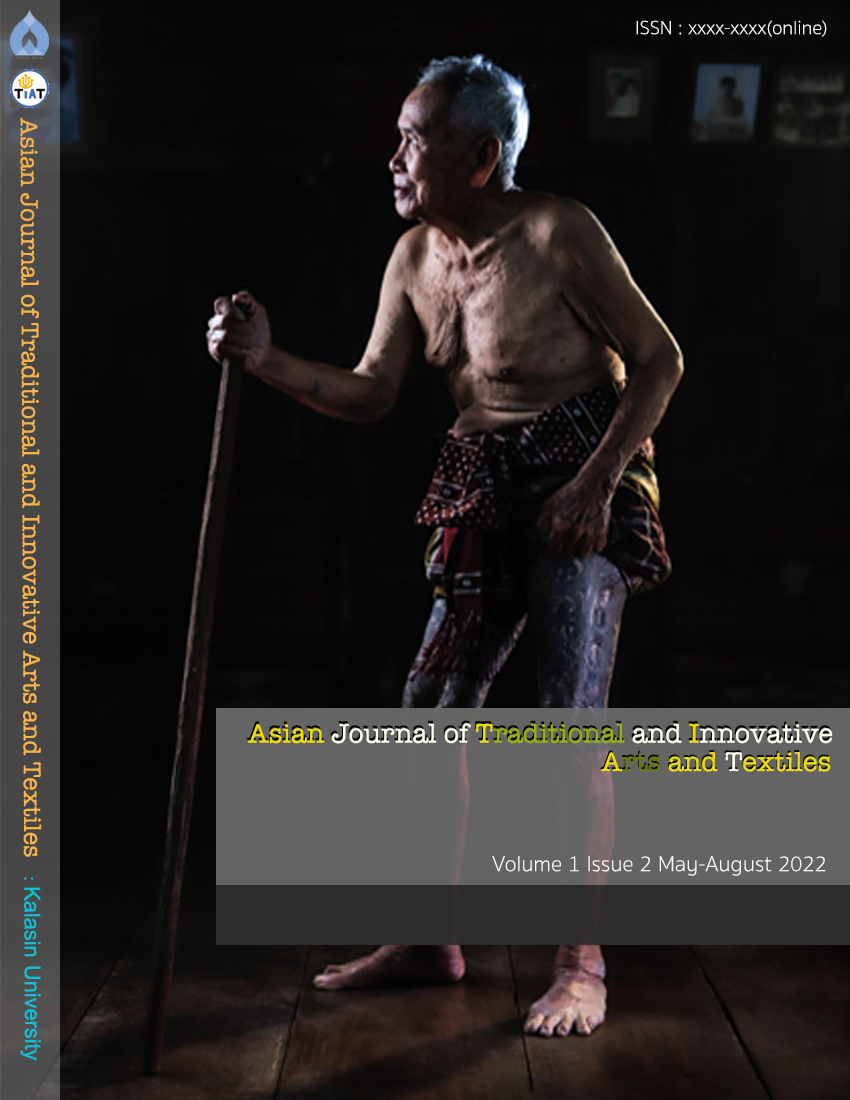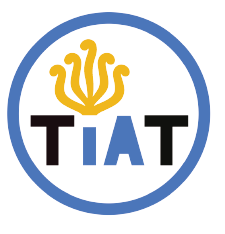Phu Tai textiles as a cultural heritage of the nation
Keywords:
Phu-Tai, Intangible cultural heritage, Textiles, Thai silk , Ethnic groupAbstract
Kalasin Province possess two pieces of cultural heritage registered as Intangible cultural heritage (ICH) by The Intangible Cultural Heritage Protection and Promotion Acts 2016for the artistry, ancient textiles; ‘Praewa’ in the year 2009 and ‘Phu Tai Textiles’ in the year 2012. In applying the concept of International Information and Networking Center for Intangible Cultural Heritage in the Asia-Pacific Region under the auspices of UNESCO (ICHCAP)on the intangible cultural heritage and sustainable development noticed the 2 items in the renowned list providing benefits in 3 dimensions. Social DimensionI.: Benefit from ICH as the body of knowledge of community has not been transferred to the new generation in both formal education and informal education systems. Benefit from ICH as social cohesion in the form of textiles identity uses. The benefit has been implemented according to the policy of Kalasin Province in order to have concreate outputs in having Prae-wa and Phu Tai Textiles as provincial identity. However, the lacking of empowered ICH to bring the province to better concert and greater interrelation with neighboring countries in the region still exists. In Environmental Dimension II, it is the benefit from ICH in the biodiversity conservation capacity issue, in which Kalasin communities can maintain local varieties of mulberry and local breeds silk worm in classic, conservative practices. In addition to the state policy formulated to promote local sericulture to Geographic Indications (GI) status and based on the Gold Class of Royal Peacock Certification (RPC). The RPC criteria strictly certified local sericulture in all the process. In the issue concerning ICH on environmental sustainability, the dominant phenomena as the Praewa and Phu Tai Textiles have been revived back to eco-friendly production in response to contemporary consumers demands. In Economic Dimension III, the benefit of ICH as an essence to group of people and their community importance, has been recognized Praewa for income generating and increasing which is better local economic situation. In the issue on ICH as the local tourism promotion in which has been lacking in cultural and community base tourism management organized as a model community in linking and base on Praewa and Phu Tai textiles. In Kalasin Province, the lacking of cultural tourist attraction that registered together with ICH still persist.
References
Amara Klumchareon and the Others. (2018). KHON. Institute of Culture and Arts Journal, Srinakharinwirot University. 20(1): 215-228.
Choocheep Auekarn and the Others. (2014). The guidelines for thai textile industrial promotion and development for global competition. Graduate School Journal Valaya Alongkorn Rajabhat University under the Royal Patronage. 8(1): 35-50.
Department of Cultural Promotion. (online). Intangible Cultural Heritage: Phu Tai Textile. Search on 31 June 2565. Search from http://ich.culture.go.th/index.php/th/ich/traditional-craftsmanship/241-craft/170-----m-s
Department of Cultural Promotion. (online). Intangible Cultural Heritage: Phu Tai Textile. Search on 31 June 2022. Search from http://ich.culture.go.th/index.php/th/ich/traditional-craftsmanship/241-craft/383-poo-thai
Division of Educational Law and Culture, Office of the Council of State. (2016). Intention of The Promotion and Conservation on Intangible Cultural Heritage Act. B.E.2016. Division of Educational Law and Culture, Office of the Council of State.
International Information and Networking Center for Intangible Cultural Heritage in the Asia-Pacific Region under the auspices of UNESCO (ICHCAP), Phoolsak Ekrojanakul (translated). (online). Intangible Cultural Heritage and Sustainable Development. Search on 31 June 2565. Search from
https://ich.unesco.org/doc/src/34299-TH.pdf.
Kalasin Provincial Office. (2021). Kalasin Province Development Plan B.E. 2018-2022 (Revised 2021). Provincial Information for Development and Strategy Working Unit. Kalasin Province
Kriangkrai Pasuta and Kanlaya Mikhama. (2018). Strategy for Livelihood among Farmers’ Households Producing Woven Fabrics Dyed with Indigo in the Nawah District Area, Nakhon Phanom Province. Nakhon Phanom University Journal. 8(2): 125-133.
Laddawan Naonadee, Jamnong Wongchachom and Suchanat Singhapad. (2019). Information Database of Mae Lai Pha Saew Phu Thai in Savannakhet Province of the Lao People’s Democratic Republic. Journal of Roi Et Rajabhat University. 13(1): 79–88.
Nittaya Wannakit. (2014). Wisdom in “Phrae-Wa Silk of Phu Thai, Baan Phon”: Dynamic and Assimilation. Journal of Thai studies. 10(2): 63-86.
Nittaya Wichachai and Karun Buapheun. (2015). The Not So Bright Future of Praewa Silk: A Theoretical Analysis. Local Administration Journal. 8(1): 27-36.
Provincial Information for Development and Strategy Working Unit, Kalasin Provincial Office. (2021). Kalasin Province Development Plan B.E. 2018-2022 (Revised 2021). Kalasin Provincial Office: Kalasin.
Ratchanikorn Kusalanon, Chadapat Sukkai and Anan Kaewtatip. (2021). Design and Development of Local Woven Fabrics to Promote Local Identity and Add Value to Cultural Products in Chiang Saen Community, Chiang Rai Province. Area Based Development Research Journal. 13(1): 16-30.
Rattanaphon Chuenka and Jariya Supun. (2020). Traditional Knowledge in Chai Nat Province for Sustainable Tourism Promotion. Inthaninthaksin Journal. 15(1): 137-167.
Royal Thai government gazette. (online). The Promotion and Conservation on Intangible Cultural Heritage Act. B.E.2016. Search on 2 February 2022, Search from http://www.ratchakitcha.soc.go.th/DATA/PDF/2559/A/019/1.PDF
Royal Thai government gazette. (2018). National Strategy (B.E. 2018-2037). Issue 135 Article 82 ก page 1.
Royal Thai government gazette. (2021). Ministerial Regulation High Education Institute Grouping B.E. 2021. Issue 138 Article 21 ก Page 1.
Somkhit Thongchuai, Ajchara Kessuvan and Ravipim Chaveesuk. (2021). Critical Success Factor for Sustainable Marketing in Thai Silk industry. Journal of the Association of Researchers. 26(4): 142-160.
Suchanart Boontiang. (2016). Pa Saew: Original of Designs on Pa Prae-wa. International Journal of Humanities and Social Sciences. 6(3): 56-70.
Upaporn Wichaidit, Sakolwan Kongmanon and Puttarat Buatama. (2022). Value Addition of Local Woven Wisdoms toward Creative Tourism. Journal of Modern Learning Development. 7(3): 347-364.
Waritsara Somkeatkun Kamon Ruengdet and Boonrirk Boonkong. (2018). Establishing of Creative Tourism Route in Chaiya District, Suratthani Province. The Mangrai Saan Journal. 6(2): 65-82.
Kittitanut Yanpisit and Suchada Surangkul. (2022). Phrae-wa studies and Driving towards Sustainable Development Goals by University for Local Development. Asian Journal of Traditional and Innovative Arts and Textiles. 1(1): 55–72.
Downloads
Published
How to Cite
Issue
Section
License
Copyright (c) 2022 Asian Journal of Traditional and Innovative Arts and Textiles

This work is licensed under a Creative Commons Attribution-NonCommercial-NoDerivatives 4.0 International License.





